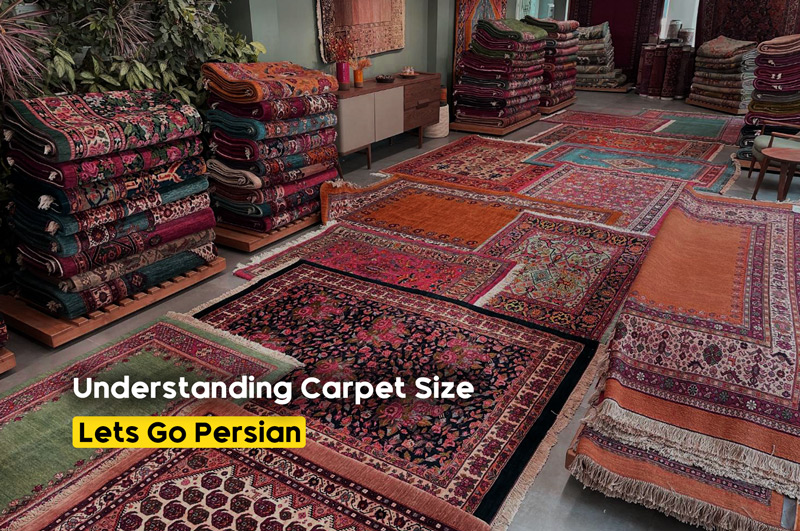
The Impact of Climate on Carpet Materials and Longevity

Knotting Techniques Used in Persian Carpets
Choosing the right carpet size is essential to enhancing the overall look and feel of your space. Whether you’re buying a Persian carpet or a modern rug, selecting the perfect size can help define a room, create balance, and make the space feel cohesive. Carpets that are too large or too small for a room can throw off the proportions and affect the functionality of the area. In this guide, we’ll explore the most common carpet sizes, provide tips on how to choose the right size for different rooms and offer practical advice to ensure your carpet complements your space perfectly.

Understanding Carpet Sizes: Finding the Perfect Fit for Your Space
1. Common Carpet Sizes and Their Uses
Before diving into specific tips for different spaces, it’s helpful to know the standard carpet sizes commonly available. While custom carpets can be made in any dimension, the following are standard sizes for most carpets and rugs:
- 3’ x 5’ (90 cm x 150 cm): This small size is perfect for entryways, small seating areas, or as accent pieces under furniture.
- 4’ x 6’ (120 cm x 180 cm): A slightly larger option, ideal for small rooms, nooks, or in front of accent furniture like bookshelves or armchairs.
- 5’ x 8’ (150 cm x 240 cm): A popular choice for medium-sized rooms, this size works well for living rooms and bedrooms where it can be partially placed under furniture.
- 6’ x 9’ (180 cm x 270 cm): This size is perfect for creating defined spaces within larger rooms, such as under a dining table or in the middle of a seating area.
- 8’ x 10’ (240 cm x 300 cm): A great option for large living rooms or open floor plans, this size can anchor a large seating area and accommodate multiple pieces of furniture.
- 9’ x 12’ (270 cm x 360 cm): Ideal for spacious rooms and formal dining areas, this size can cover a large area and unify furniture pieces.
- 10’ x 14’ (300 cm x 420 cm): For grand living rooms or large dining spaces, this size offers full coverage and can handle oversized furniture arrangements.
2. Choosing the Right Carpet Size for Different Rooms
Living Room: Creating Defined Spaces
The living room is one of the most important spaces for incorporating a well-sized carpet, as it can help anchor the seating area and create a sense of coziness.
- Full Room Coverage: In a large living room, a 9’ x 12’ or 10’ x 14’ carpet is ideal for providing full coverage, with all the furniture (sofas, chairs, tables) fully placed on the carpet. This creates a unified and grounded look.
- Partial Under Furniture: A 5’ x 8’ or 6’ x 9’ carpet can work well if you want only the front legs of the furniture to sit on the carpet, leaving the back legs off. This helps define the seating area without overwhelming the space.
- Small Living Room Spaces: In small living rooms or apartment settings, a 4’ x 6’ carpet placed in front of the seating arrangement can add a pop of color or pattern without dominating the space.
Tip: Ensure that the carpet is large enough to reach under at least part of the furniture (such as the front legs of the sofa or chairs) to avoid the “floating” look of a small rug in the middle of a seating area.
Dining Room: Anchoring the Table and Chairs
In the dining room, the carpet size should be large enough to accommodate both the dining table and the chairs, even when they are pulled out.
- Under the Table: A 6’ x 9’ carpet works for smaller dining tables, while larger dining tables may require an 8’ x 10’ or 9’ x 12’ carpet. The goal is to ensure that the carpet extends at least 24 to 30 inches beyond the edges of the table so that the chairs remain on the carpet even when pulled out.
- Shape Matching: If your dining table is rectangular, a rectangular carpet works best. For a round table, a round carpet or a large square carpet can help create symmetry.
Tip: Measure your table with the chairs fully pulled out to ensure the carpet will be large enough to accommodate the chairs without leaving the legs off the edge when in use.
Bedroom: Soft Underfoot Comfort
Carpets in the bedroom add warmth and softness underfoot, especially when stepping out of bed. The right carpet size depends on the size of the bed and the room layout.
- Under the Bed: For a queen bed, a 6’ x 9’ or 8’ x 10’ carpet is ideal. The carpet should be placed partially under the bed, with the majority of the carpet extending out from the foot and sides of the bed. For a king-size bed, opt for a 9’ x 12’ or larger carpet to ensure adequate coverage.
- Side Placement: If you prefer not to place the carpet under the bed, consider placing runners or smaller carpets (such as 3’ x 5’) on each side of the bed to provide a soft landing for your feet.
Tip: Avoid placing the carpet only under the top half of the bed (from the headboard down), as this can make the room feel unbalanced.
Hallways and Entryways: Adding a Welcoming Touch
Carpets in hallways and entryways not only add visual interest but also provide practical benefits by protecting the floor from dirt and wear.
- Runners for Hallways: In narrow hallways, runners (typically 2’ x 8’ or 3’ x 10’) work well to create a welcoming path. Ensure the runner is centered in the hallway, leaving equal space on either side.
- Entryway Carpets: In entryways, a 3’ x 5’ or 4’ x 6’ carpet can define the space and offer a warm welcome. Choose a durable material like wool to withstand heavy foot traffic.
Tip: Make sure the door can easily open and close without catching on the carpet.
3. Tips for Finding the Perfect Carpet Size
Measure Your Space First
Before buying a carpet, it’s essential to measure the area where you plan to place it. Measure both the length and width of the space to ensure the carpet fits comfortably within the dimensions of the room.
- Leave Some Space Around the Edges: In most rooms, you’ll want to leave some floor visible around the edges of the carpet, typically 12 to 18 inches. This helps the carpet feel balanced within the room and prevents it from looking too small or too large.
Consider Furniture Placement
When determining the right carpet size, think about how your furniture will sit on the carpet. For example:
- Full Coverage: If you want the entire furniture arrangement (such as a sofa, chairs, and coffee table) on the carpet, choose a larger size that allows the legs of all the furniture to sit on the carpet.
- Partial Coverage: If you prefer only part of the furniture to sit on the carpet, such as just the front legs of the sofa, a medium-sized carpet may work better.
Visualize with Painter’s Tape
A helpful way to visualize how a carpet will fit in your space is to use painter’s tape to mark out the dimensions of the carpet on the floor. This technique gives you a clear idea of how the carpet will look about your furniture and helps prevent purchasing a carpet that’s too large or too small.
Shape Matters
The shape of the carpet can also influence the overall look of a room. While most carpets are rectangular, round carpets or square carpets can add interest to certain spaces, such as dining rooms with round tables or intimate seating areas.
4. Custom Carpets for Unique Spaces
If your space has unusual dimensions or you want a more personalized option, you may consider a custom-sized carpet. Many carpet manufacturers and weavers offer custom sizing, allowing you to create the perfect fit for your room.
- Oddly Shaped Rooms: Custom carpets are ideal for rooms with irregular shapes, nooks, or alcoves where standard sizes won’t work.
- Oversized Areas: For especially large rooms, a custom-sized carpet ensures you get full coverage without having to piece together multiple smaller rugs.
Conclusion
Choosing the perfect carpet size is essential for creating a harmonious and well-designed space. Whether you’re selecting a Persian carpet for your living room or a modern rug for your dining area, the right size can transform the look and functionality of your room. By considering the layout, measuring your space, and using visualizing techniques, you can find a carpet that fits perfectly and enhances the beauty and comfort of your home.



















